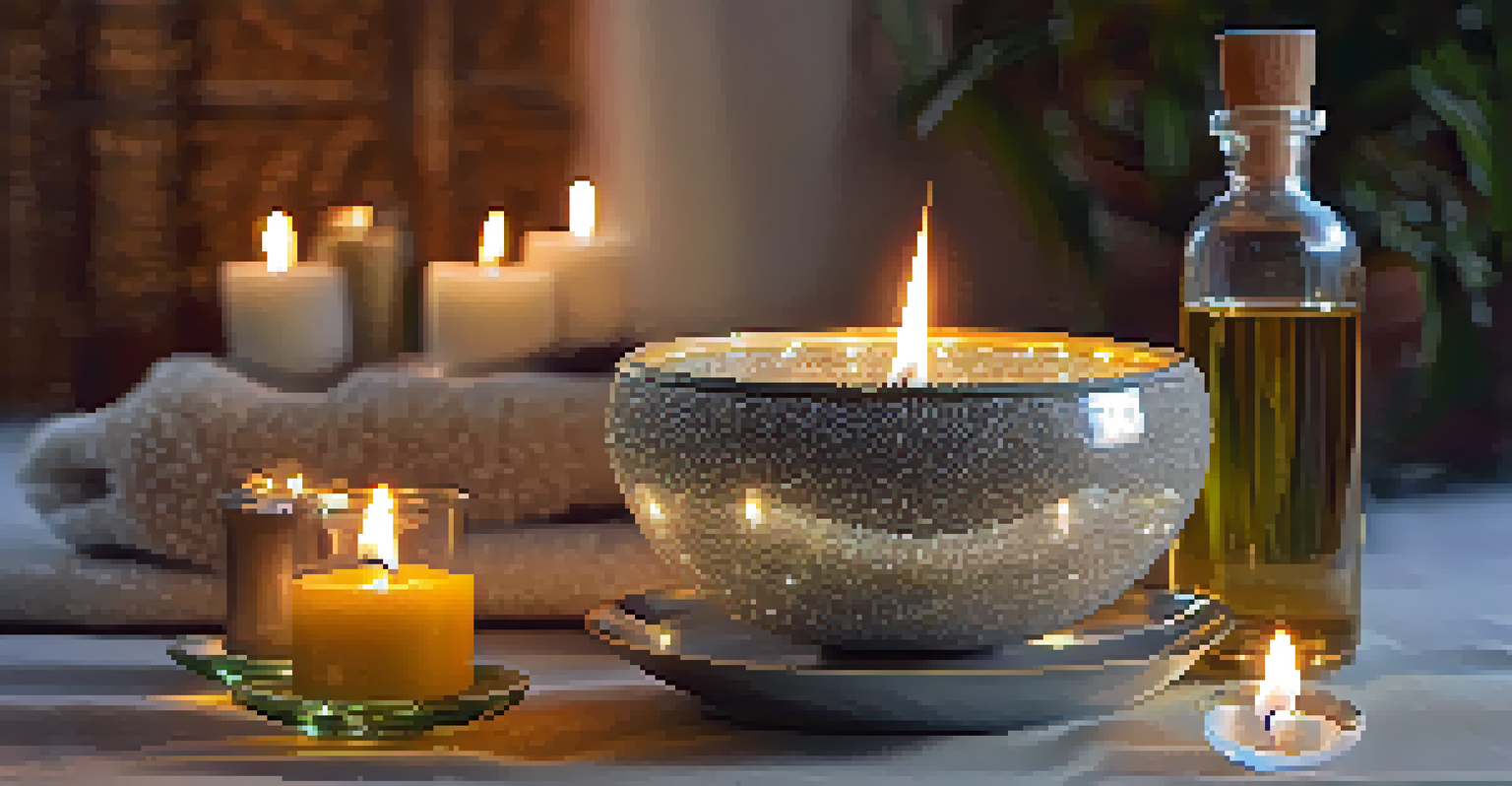Breath and Sound: Harmonizing Yoga with Healing Frequencies

Understanding the Connection Between Breath and Sound
Breath and sound are deeply intertwined in yoga, creating a symbiotic relationship that enhances our practice. When we breathe consciously, we can influence the sounds we produce, whether through chanting or simply vocalizing. This connection is not just about making noise; it's about creating vibrations that resonate within us and around us, fostering a sense of harmony.
The breath is the bridge which connects life to consciousness, which unites your body to your thoughts.
Consider how the ancient practice of chanting 'Om' serves as a perfect illustration. This sacred sound embodies the essence of the universe, and when we chant it while focusing on our breath, we align our inner selves with the greater cosmos. This alignment can lead to profound experiences during yoga, as the sound vibrations help us connect with our body and mind.
By being aware of our breath and the sounds we create, we can tap into a more profound level of awareness during our yoga practice. This awareness allows us to explore not just the physical aspects of yoga, but also the emotional and spiritual dimensions, making our practice holistic and complete.
The Science Behind Healing Frequencies
Healing frequencies refer to specific sound vibrations that can promote physical and emotional well-being. Research shows that certain frequencies, like 432 Hz, have a calming effect on the mind and body, making them perfect for use in yoga sessions. By incorporating these frequencies into our practice, we can enhance relaxation and stress relief.

For instance, sound therapy often utilizes tuning forks or singing bowls tuned to these healing frequencies. When combined with breathwork, these sounds can create a soothing environment that fosters deep relaxation and introspection. Imagine lying on your mat, enveloped in the resonance of a singing bowl, while your breath flows naturally - it’s a transformative experience.
Breath and Sound Enhance Yoga
The integration of conscious breathing and sound in yoga fosters a deeper connection and promotes holistic well-being.
The magic happens when we allow these healing sounds to guide our breath. As we inhale and exhale, we can imagine our breath flowing in sync with the vibrations, promoting a deeper sense of calm and connection. This synergy can be incredibly powerful, leading to emotional releases and greater self-awareness.
Incorporating Breath and Sound into Yoga Practice
Integrating breath and sound into your yoga routine doesn’t have to be complicated. Start by choosing a mantra or sound that resonates with you, such as 'Om' or a simple word like 'peace'. As you move through your poses, let this sound become your focus, allowing your breath to flow naturally with it.
Sound is the medicine of the future.
For example, during a challenging pose like Warrior II, you might inhale deeply, and as you exhale, softly chant your chosen sound. This practice not only distracts from any discomfort but also helps ground you in the present moment. It’s a simple yet effective way to deepen your connection to your practice.
Additionally, you might explore the use of instruments like singing bowls or chimes during your practice. These sounds can serve as a backdrop, guiding your breath and movement. As you listen to these healing frequencies, they can help you find your rhythm and enhance your overall experience.
The Role of Breath in Sound Meditation
Sound meditation is a practice that utilizes sound frequencies and vibrations to promote relaxation and healing. Breath plays a pivotal role in this process, as it helps us anchor ourselves in the present moment. By focusing on our breath, we can create a meditative state that allows the sounds to wash over us.
Imagine sitting comfortably, eyes closed, as soothing sounds envelop you. With each breath, you can feel the vibrations resonating within your body, creating a sense of peace and tranquility. This meditative experience can lead to insights and emotional releases that enhance your overall well-being.
Healing Frequencies Promote Relaxation
Utilizing specific sound vibrations, such as 432 Hz, can enhance relaxation and emotional healing during yoga practice.
As you engage in sound meditation, remember that your breath is your guide. Allow it to flow naturally as you listen to the healing frequencies, enhancing your connection to the sounds. This practice not only calms the mind but also opens the heart, fostering a deeper connection to yourself and the world around you.
Exploring Different Sound Healing Techniques
There are many sound healing techniques that can complement your yoga practice. From crystal bowls to gongs, each instrument has its unique vibration and effect on the body. Exploring different methods can help you find what resonates best with you and enhances your practice.
For instance, Tibetan singing bowls are known for their rich, resonant tones that can help release tension and promote relaxation. When paired with breathwork, these bowls can create a deeply immersive experience, allowing you to connect with your inner self on a profound level. The sound waves interact beautifully with your breath, creating a harmonious flow.
Another popular technique is the use of drumming, which can elevate your energy during a yoga session. The rhythmic beats can sync with your breath, encouraging movement and a sense of grounding. By experimenting with various sound healing techniques, you can discover new ways to enhance your yoga practice and foster a deeper connection to your body.
Creating a Sound and Breath Ritual for Your Practice
Creating a personalized sound and breath ritual can enhance the depth and effectiveness of your yoga practice. Start by setting an intention for your session, then select a sound or mantra that aligns with that intention. This can help to anchor your practice and provide a focal point.
Next, consider the environment in which you practice. Choose a space that feels calming and inviting, perhaps with soft lighting or comfortable seating. Adding elements like candles or essential oils can also create a sensory experience that enhances your connection to the sounds and your breath.
Creating Personal Sound Rituals
Establishing a personalized sound and breath ritual can deepen the effectiveness of your yoga practice and enhance self-awareness.
As you go through your ritual, allow yourself to be fully present. Focus on your breath and the sounds you are creating. This intentional approach can lead to a more profound, transformative experience, allowing you to step away from your practice feeling rejuvenated and centered.
The Benefits of Harmonizing Breath and Sound in Yoga
Harmonizing breath and sound in yoga has numerous benefits that extend beyond the mat. This practice can enhance relaxation, reduce stress, and promote emotional healing. When we engage in breath and sound harmonization, we’re essentially creating a safe space for ourselves to explore our feelings and release tension.
Moreover, this synergy fosters a greater sense of community when practiced in group settings. Sharing sounds and breaths with others can create a collective energy that enhances the experience. Imagine being in a room filled with like-minded individuals, all harmonizing their breaths and sounds - it’s a powerful and uplifting experience.

Ultimately, harmonizing breath and sound can lead to a deeper understanding of ourselves and our connection to the universe. It invites us to tune in to our bodies and minds, promoting self-awareness and growth. As we embrace this practice, we cultivate a sense of peace and balance that can positively impact all areas of our lives.